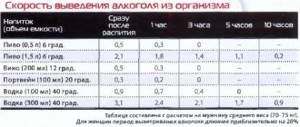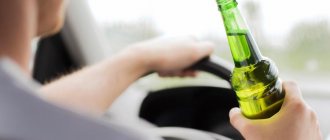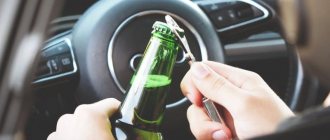Blood alcohol level
What is ppm? This is one thousandth of something, it equals 0.1%. If they say that there is 1 ppm of alcohol in the blood, this means that in a liter of blood 0.1% ethyl alcohol is 1 gram.
Degrees of intoxication and number of ppm. Doctors use this table:
| Degree of intoxication | Alcohol in blood, ppm |
| light | 1-2 |
| average | 2-3 |
| heavy | 3-4 |
| "alcohol coma" | 4 and above |
Period of complete elimination from the body in hours. The rate of elimination of ethyl alcohol from the body is on average 0.1-0.2 ppm per hour. The speed is affected by the following parameters: height, weight and gender. For example, 100 ml of vodka after 6 hours will not leave any traces in the body of a man weighing 80 kg and height 175 cm.
Permille - what is it
As is known, most terms in international measurement systems, chemistry and forensic medicine have Latin roots. Permille is translated from Latin as one thousandth, or one tenth of a percent. The unit of measurement is designated ‰ and is used to determine the number of thousandths of something in the overall whole.
In other words, it's about concentration.
In our case, the level of alcohol in the driver’s blood, urine or exhalation is measured.
How to check your blood alcohol level
A drunk driver is a danger to himself and to other road users. It is precisely because of the increased danger that the punishment for such citizens is especially severe, and the government, by a separate order, approved the rules for testing drivers for intoxication. Here are the main points.
Reasons for checking. If the inspector has reason to believe that the driver is drunk, he will send him for a medical examination. Reasons are one or more signs of driver intoxication:
- smell of alcohol from the mouth;
- stands unsteadily;
- speaks incoherently;
- the face quickly turns red or pale;
- behaves inappropriately to the situation, for example, waving his arms and shouting.
On-site inspection. The driver is told the testing rules and is asked to exhale into a special device - a breathalyzer. The driver can get out of his car, but is not required to. The inspector knows how many ppm you are allowed to drive in 2021, and therefore can send you for a re-inspection.
Re-check. If the device detects at least 0.16 milligrams of alcohol per liter of exhaled air, the driver will be asked to blow into the tube again after 15-20 minutes.
Protocol. If during the second test the device again shows the same result, the driver will be declared drunk and a report will be issued about this. The inspector will send this protocol to the court. If the breath alcohol tester does not show any results, the driver will be released.
Check with a health worker. A driver will be sent to be checked at a medical facility or mobile medical examination center if he:
- refused on-site inspection;
- does not agree with the results shown by the inspector’s device;
- still drunk according to the inspector. This is possible if the device has been in the cold for a long time or, in the opinion of the inspector, is faulty.
The health worker will test the exhaled air and military materials - urine and blood - for alcohol.
If the driver is found to have alcohol, the medical worker makes a note about this in the report - the traffic police officer attaches this document to the protocol and sends it to the court.
In all cases where the test results show that the driver is drunk, the car is sent to the impound lot. Let us remind you that the permissible amount of ppm in exhaled air in 2021 is 0.3.
Falsification of tests. Some drivers try to give the doctor fake urine or dilute it with water. At mobile and stationary urine testing points there are special booths where drivers make the change.
But doctors check temperature, acidity, density and several other parameters that allow them to establish the fact of falsification. If the health worker discovers this, he will make a note about it in the report.
Substitution according to the law is equal to refusal of examination. And the punishment for this is a fine of 30,000 rubles with deprivation of rights for up to 2 years.
More modern breathalyzer models have a miniprinter - it prints the test result. The inspector will attach this printout to the protocol. Source: draeger.com
Alcohol testing by an inspector
Suppose you were stopped by a traffic police officer, introduced himself and correctly asked to “blow” into the phone. This means that he has good reason to suspect you of drinking alcohol. Of course, you have the right to refuse, but if you agree, the procedure and procedure must comply with each point of the approved regulations put into effect by Order of the Ministry of Internal Affairs No. 664 of 08.23.17.
Reports on the violation, removal from driving the vehicle and referral for a medical examination must be drawn up. Today, the law does not require drivers to take an alcohol test right on the road, but the traffic police officer must explain what grounds he has for checking.
How to appeal the results of an inspection
Errors in the protocol. If the case goes to court and the driver has arguments in his own defense, he can report errors when drawing up the protocol:
- there were no witnesses or video recording of testing;
- the information in the document does not correspond to the facts, for example, the driver’s words are distorted;
- Incorrect data: names, dates or places.
Errors in testing. During testing, the driver is required to exhale into a special tube that is attached to the breathalyzer itself - a mouthpiece. The inspector should only use a new tube - remove it from its sealed packaging. This is necessary so that after the previous inspection there are no traces of saliva or alcohol left in the tube, and also to exclude forgery on the part of the inspector.
If the driver notices that the mouthpiece is already on the device, he must insist that this fact be recorded in the protocol.
Modern breathalyzers are equipped with a mini-printer - the driver must pay attention to the data in the printout, which the inspector will attach to the protocol. If it does not contain today’s date or the readings are clearly exaggerated, you need to mention this in the protocol or not sign the document at all. Inflated readings, for example, are as follows: the driver drank a mug of weak beer, but the device shows that he drank a bottle of vodka - this is 2.5 ppm. This is much higher than the ppm allowance for driving in Russia in 2021.
Also, at the driver’s request, the inspector must show documents for the breathalyzer, indicating that the device is registered and in working order. To check whether the device is registered, you need to go to the website of the register of approved measuring instruments and enter “ethanol” in the “Name of measuring instruments” column.
Next, through the search on the page, find the word “exhaled” or words similar to it. Search on a page - keyboard shortcut Ctrl+F on Windows or ⌘+F on Mac
As a result, you will find information about all registered devices. If the test was carried out with a device that is not registered, this will help to challenge the data from the protocol.
If the driver wants to retest the blood and urine, for example, in a private laboratory, he can do this - the samples are stored in the medical institution for three months. And the results obtained using special devices last for 5 years.
In any case, when the driver does not agree with the verification procedure, he has the right not to sign the protocol.
What is ppm and how is it determined?
Drunk driving is dangerous - alcohol actively affects the driver’s psyche, reduces concentration and reaction time to a traffic situation, forces you to make wrong decisions and leads to serious car accidents.
However, the blood alcohol level is not constant - the more time passes after drinking alcohol, the lower the proportion of alcohol in the blood. That is, a drunk person gradually sobers up over time due to the gradual removal of alcohol from the body. The speed of sobering is determined by ppm.
Promille is the minimum unit that determines the alcohol content in a liter of human blood. One ppm is equal to 0.1% (that is, 1 mg of alcohol per liter of blood), and this amount of alcohol can be produced and contained in a completely sober body. This figure may naturally be higher if a person suffers from certain serious diseases (diabetes, hepatitis, endocrine and oncological diseases, disorders of the gastrointestinal tract, stress, etc.).
It is believed that the rate of alcohol removal from the blood averages up to 0.15% (1.5 ppm) per hour. However, this is a very approximate indicator, which depends on the characteristics of the human body, the speed of metabolic processes and the physical condition of the person. If you drink alcohol, the process of “cleansing” the body to normal will naturally increase to several hours. During this period, the car owner may not control his reactions and poses a danger while driving.
Is it possible to mitigate the punishment or fine?
The judge may impose a minimum term of imprisonment of 1.5 years instead of 2 years.
Alexander Torvard, car lawyer For drunk driving, in addition to a fine, there is a “delta” of penalties - a period of deprivation of rights from 1.5 to 2 years. When determining the term, the judge will take into account mitigating and aggravating circumstances. Mitigating factors include, for example, remorse, the presence of dependents and the absence of previous violations. These circumstances cannot completely exempt you from liability. Aggravating circumstances include repeated violation of the law under the same article of the code or unwillingness to admit to the crime.
Fines for driving while intoxicated
Driving while drunk carries administrative or criminal liability.
According to the Code of Administrative Offenses (Article 12.8), a drunk driver is liable for exceeding the permissible level of alcohol in the blood - a fine of up to 30,000 + deprivation of rights for 15.2 years, and additionally:
- for lack of a driver's license - arrest for 10-15 days or a fine of up to 30,000 rubles;
- for refusal of examination - up to 30,000 rubles + deprivation of driver's license for 1.5-2 years;
The car is impounded and taken to the impound lot.
According to the Criminal Code of the Russian Federation (Article 264), criminal liability arises when driving a car while drunk again or causing a fatal accident. In particular, if the driver is drunk:
- and caused harm to human health during an accident - up to 3-7 years in prison;
- and caused the death of a person - up to 5-12 years in prison;
- caused the death of 2 or more people - up to 8-15 years in prison.
If you drive a car again or refuse to undergo an examination - a fine of 200-300,000 rubles, up to 2 years of imprisonment, up to 480 hours of community service or up to 2 years of forced labor.
You can appeal the results of a traffic police alcohol test only in court if you have serious arguments, supported by documents, or evidence that your blood alcohol content exceeds the norm due to other circumstances.
Remember
- The amount of ppm alcohol allowed in 2021 is 0.3 ppm in exhaled air.
- The inspector has the right to check the driver if he cannot stand, speaks incoherently or behaves inappropriately.
- The driver may not agree with the test results and insist on medical testing.
- If you refuse to check completely, the law will equate it to drunk driving.
- If the driver does not agree with the results of the check, he can reflect this in the protocol or not sign the protocol at all. Then you will have to prove your case in court.
- If alcohol is detected above the ppm alcohol limit in Russia in 2021, the driver will be deprived of his license for up to 3 years and fined 30,000 rubles.
- A mitigation of the punishment is possible - the judge can reduce the period of deprivation of rights to 1.5 years.
All articles by the author: Evgeniy Lesnov
Difference and relationship between ppm in blood and alcohol concentration in exhalation
It is more convenient to calculate the permitted alcohol content in exhaled air in milligrams per liter, which is given by a breathalyzer. This is explained by the fact that the main purpose of using this device is to determine not the degree, but the fact of intoxication.
For a more accurate assessment, a blood test is used. It is with such a study that we are talking about ppm, which really allows us to estimate how much alcohol is contained in the body. It is clear that it is difficult to use blood volume for calculations, so the mass of a person is taken as the reference point. Invented by the Swedish chemist Widmark almost 100 years ago, the formula takes into account the mass of ethanol drunk in grams, body weight in kilograms and a distribution coefficient that is different for men (0.7) and women (0.6). New calculation standards have not been proposed since then, and scientists have calculated the approximate ratio between milligram/liter and ppm to be 0.45. In other words, 1 ‰ is equal to 0.45 mg/l.
Another problem that many drivers will face is related to the use of medications. Among them there are many alcohol-containing ones. Twenty drops of valerian or valocordin - and you risk being left without a license for two years. Plus, sophisticated technology can calculate ppm for a completely sober person who has an inflammatory process in the oral cavity, for example stomatitis.
However, in the instructions for breathalyzers, almost all of this is spelled out in black and white: “The breathalyzer is sensitive to volatile organics (ethyl and methyl alcohol, gasoline, turpentine, ether, acetone, camphor, hydrogen sulfide, acetic acid, phenol, dichloroethane, validol vapor, menthol, chloroform, kerosene, alkali, ammonia, chloral hydrate, ethylene glycol, etc.). The sample should not be taken immediately after eating, smoking or taking medication. It is not advisable to brush your teeth, chew gum, suck mints or drink coffee.”
That is, formally, a police officer must give the driver time to “breathe” after lunch or a cigarette, but where will you see this?
It is also possible that the expression “caught on the residue,” that is, on the residual effect from the use of alcohol, will become firmly entrenched in the vocabulary of traffic police officers. The problem is the quantity of these very residues. The fact is that each person’s body breaks down alcohol differently. “If there are liver lesions, then this process occurs more slowly,” says Yuriy Sivolap. “Or, let’s say, the breakdown of alcohol is difficult for residents of Asia - due to an insufficient amount of liver enzymes responsible for the breakdown of alcohols.” In this case, the cause of a positive reaction to alcohol could be a couple of glasses of vodka drunk at yesterday’s lunch.
In addition, do not forget that instruments intended for examination have an error. According to road safety expert Sergei Nesterov, it can vary from 0.01 to 0.1 ppm. So what if you don’t feel any guilt?
“For those drivers who take strong or alcohol-containing medications, it is best to have a medical certificate with them, which would indicate this point,” says lawyer Alexander Molokhov. — In the event that you do not feel guilty and did not drink alcohol, you will have to get from the traffic police post to the nearest hospital on your own. Moreover, this will need to be done within an hour in order to undergo a second independent test of the body for the presence of alcohol in the blood. Then this document will become a valid basis to protest the actions of the traffic police officers in court.”
The paradox of numbers
However, the effect of introducing strict standards can be easily refuted with the help of a small statistical study. For example, in 2007, 15,593 accidents occurred due to drunk drivers. A year later, a standard of 0.3 ppm was introduced, that is, a relaxation was made for lovers of strong drinks. However, in 2008, there were 12.7 percent fewer “drunk” accidents on the country’s roads—13,611. And in 2009, this figure decreased by another 9.4 percent. But how can we explain this paradox? Is it really the introduction of a standard of 0.3 ppm? Hardly. The curve of the number of accidents and victims went down after a new type of punishment was introduced in 2004 - deprivation of rights for up to two years for driving while intoxicated.











